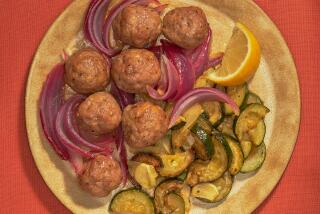The Dinner Sour
- Share via
We tend to take vinegar for granted. Some people think that having tasted one they have tasted them all. But the flavors of two red wine vinegars may vary even when their acidity is the same. Just imagine, then, how different vinegars can be when they are made out of different fruits.
Vinegar guidelines are simple: For general cooking, use wine or cider vinegar. For salads, almost any vinegar will work, although many people prefer wine vinegars on their lettuce. For pickling and preserving, you’ll want to use cider vinegar or distilled white vinegar.
For me, red wine vinegar is the most useful to have on hand. It’s easy enough to make if you can beg or borrow a “mother,” the natural yeast culture that turns leftover wine into vinegar. You can then flavor it with basil, tarragon or another herb, steeping your favorite fresh herbs in the vinegar for at least a week.
Taste vinegar before you use it so that you will know how strong it is. Vinegars can vary enormously. Remember that it’s better to start light and add more because a vinegar overload is very difficult (if not impossible) to correct.
Kent Buell, chef at Betise restaurant in Plaza del Lago in Wilmette, Ill., shares my passion for vinegar. He uses varied vinegars to give a distinctive edge to many of his dishes. The three following recipes each depend on a different kind for flavor.
Serve these delicious potatoes with roasts, fish and poultry. They are also an excellent base for a warm potato salad.
BALSAMIC ROASTED NEW POTATOES 2 tablespoons olive oil 2 pounds small new potatoes, washed, patted dry, quartered 1 tablespoon minced garlic 1 tablespoon minced shallot 1 teaspoon fresh thyme 1 teaspoon minced rosemary 1/8 teaspoon freshly ground nutmeg 1/4 cup balsamic vinegar Salt, pepper
Heat olive oil in 12-inch skillet over medium-high heat. Add potatoes, garlic and shallot. Toss in skillet until well mixed. Add thyme, rosemary and nutmeg. Toss well again. When potatoes are hot, transfer to baking sheet and spread in single layer. (Can be made several hours ahead to this point.)
Place sheet on rack in lower third of 400-degree oven. Roast potatoes until golden and just tender, about 25 minutes, turning once midway. Add vinegar. Toss well. Season to taste with salt and pepper. Return to oven until sizzling, about 7 minutes. Serve immediately. Makes 6 servings.
Each serving contains about: 165 calories; 59 mg sodium; 0 cholesterol; 5 grams fat; 29 grams carbohydrates; 3 grams protein; 0.75 gram fiber.
There’s no fat in the dressing of this salad, which is also good served with crudites. It’s best to cook the beans and potatoes the day the salad is served, as they taste better without refrigeration. Let the potatoes cool out of the water so they retain as little moisture as possible.
BETISE’S SALADE 6 cups mixed baby greens, washed 8 small red potatoes, boiled and sliced 24 cooked green beans Yogurt Dressing Salt, pepper
Combine chilled greens in large bowl with potatoes and green beans. Add 3/4 cup dressing. Toss well. Add more dressing as desired. Season to taste with salt and pepper. Serve immediately. Makes 4 servings.
Each serving contains about: 196 calories; 237 mg sodium; 1 mg cholesterol; 1 gram fat; 38 grams carbohydrates; 7 grams protein; 1.21 grams fiber.
Yogurt Dressing 1 cup nonfat plain yogurt 2 tablespoons Sherry wine vinegar 2 teaspoons Dijon mustard 1 teaspoon chopped parsley 1 teaspoon chopped fresh tarragon 1 teaspoon chopped fresh thyme 1 teaspoon chopped fresh chervil 1 1/2 teaspoons honey Salt, pepper
Combine yogurt, vinegar, mustard, parsley, tarragon, thyme, chervil, honey and salt and pepper to taste in small bowl. Add 1 teaspoon water if needed for consistency.
Adjust seasonings to taste. Let stand at room temperature 10 minutes. Stir well and adjust seasonings to taste.
Buell often uses vinegars in place of wine to de-glaze a pan. He finds that the vinegar’s acidity works especially well with fish, such as bass, halibut, snapper and salmon. Balsamic vinegar can be substituted here, if desired.
PAN-FRIED SALMON WITH RED-WINE VINEGAR AND MUSHROOMS 1 tablespoon peanut oil 2 (5-ounce) salmon fillets, washed, patted dry Salt, pepper 1/3 cup red-wine vinegar 8 medium mushrooms, sliced 1 1/2 tablespoons butter
Heat oil in 10-inch non-stick skillet over medium-high heat. Sprinkle salmon with salt and pepper to taste. Place fillets in skillet, skin side up, and cook until well browned on under side, about 4 minutes. Gently turn with spatula. Cook, covered, until salmon is just done. Timing will depend on thickness of fish, at least 3 more minutes for thin tail piece.
Transfer fish to 2 warm dinner plates. Place plates in warm oven while finishing sauce.
Pour vinegar into skillet. Stir well with wooden spoon. Add mushrooms. Simmer until mushrooms are just tender, about 3 minutes. Remove from heat. Stir in butter until melted. Adjust seasonings to taste. Spoon over fish. Serve immediately. Makes 2 servings.
Each serving contains about: 351 calories; 301 mg sodium; 79 mg cholesterol; 24 grams fat; 3 grams carbohydrates; 31 grams protein; 0.07 gram fiber.
More to Read
Eat your way across L.A.
Get our weekly Tasting Notes newsletter for reviews, news and more.
You may occasionally receive promotional content from the Los Angeles Times.







